Introduction
September through November is always busy
for us, since many big and important meetings for Interventional
Cardiology are held everywhere in the world. Among them
TCT,
CCT and Kiemeneij Course are especially important for me.
I flied from Narita Airport to Dulles International Airport
at Washington DC, USA by ANA flight (NH 002) on September
26 Sunday, 2004 in order to attend TCT 2004 meeting. TCT
means "Transcatheter Cardiovascular Therapeutics".
This meeting is one of the oldest and biggest live demonstration
course for Interventional Cardiology and conducted by Dr.
Martin Leon and his colleagues. In terms of the number of
attendance, EuroPCR might be bigger than TCT. However, TCT
is clearly bigger than EuroPCR
in terms of the size. I published my article titled "Initial
clinical experiences with rescue unipolar radiofrequency
thermal balloon angioplasty after abrupt or threatened vessel
closure complicating elective conventional balloon coronary
angioplasty" in Journal of the American College of
Cardiology in 1994 (J Am Coll Cardiol 1994: 24; 1220-1228).
Because of this publication, I was invited by Dr. Leon next
year and did 15 minutes' lecture on "Radiofrequency
Hot Balloon Coronary Angioplasty" in the main arena.
That time, the invited faculty members from Japan were only
Dr. Nobuyoshi and I. Since then, I am one of the international
invited faculty members of this meeting just for 10 years.
This year, live case demonstrations were transmitted from
12 centers in the US, 11 centers in Europe, 1 center in
Canada as well as 1 center in Asia-Pacific area. Asian center
was Asan
Medical Center in Seoul. On September 24 Friday, 1999,
I transmitted my live cases to TCT from ShonanKamakura General
Hospital. Because there is 13 hours' time difference between
Japan and Washington DC, I did angioplasty from 9:00 PM
to 10:00 PM (8:00 AM to 9:00 AM in Washington DC) and from
11:00 PM to 12:00 PM (10:00 AM to 11:00 AM in Washington
DC). I myself did 7 cases by TRI during these 2 hours transmission
time. I still clearly remember how this transmission was
difficult but very exciting.
The airplane arrived at Dulles International Airport around
10:30 AM on September 26 Sunday, 2004. The immigration process
was not so hard. Since it was too early to check in the
hotel, I and Dr.
Hiroshi Domae, who is the youngest doctor in my department
and joined to present a case presentation, directly went
to a Chinese restaurant to have a lunch near the hotel by
30 minutes' drive by a taxi. After that, I checked in the
Renaissance Hotel near the Convention Center at 2:00 PM
and slept down for 3 hours in my room. We had an American-style
dinner together with Dr. Mitchell Krucoff of Duke University
Clinical Research Institute. I ordered Chateau-Briand steak
for main dish. The taste was very good, the volume was too
much. While having the dinner, we discussed about how we
could make any contribution to promote good-quality clinical
studies in Japan. The discussion was very meaningful for
me.
September 27 Monday, 2004
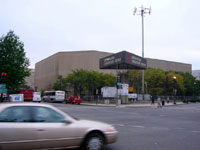 |
Old Convention
center |
After having a breakfast, I walked to the
Washington Convention Center. Washington DC had an old convention
center. However, its building was old and too small to have
big meetings. Washington DC Government decided to build
a new convention center under the redevelopment plan of
the city.
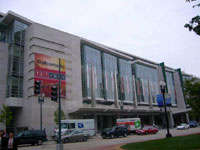 |
New Convention
center |
|
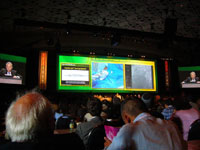 |
Main Arena |
|
The new Convention Center was built just
1 block apart from the previous one. The new one is a huge
building.
I walked in the Faculty Lounge, received the registration
budge, the reimbursement form, and so on, and then moved
to the Main Arena. The live demonstrations from Heart Center
Sieberg, Germany and Presbyterian Hospital of Columbia University,
New York were transmitted at that time there. Dr. Eberhard
Grube showed the live demonstration for a new self-expandable
drug-eluting bifurcation stent. From New York, they showed
a new-type cutting balloon.
Those live transmissions finished about 30 minutes behind
the original schedule so that the lecture by Professor Patrick
Serruys titled "How Drug-Eluting Stents Have Changed
Interventional Cardiology" started from 10:30 AM. He
showed the history of the development of drug-eluting stents.
Next to him, Dr. Gregg Stone made the lecture titled "Drug-Eluting
Stent Euphoria in the US". He stressed how evidence-based
medicine was important especially in the era of drug-eluting
stents.
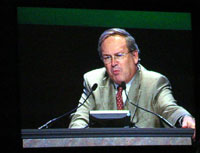 |
Professor Patrick
Serruys |
The newest results of many important clinical
trials are shown during TCT meeting every year. The most
exciting result for me was from ARTS-II study. The result
was shown by the Principle Investigator of the trial, Professor
Patrick Serruys. ARTS means "Arterial Revascularization
Therapies Study", in which the treatment efficacies
for multi-vessel diseases are compared between stent-based
PCI and CABG. ARTS-I trial was conducted in the era of bare-metal
stents. In ARTS-II study, they compared the registry data
of Cypher drug-eluting stent PCI for multi-vessel disease
in 607 patients with those from the CABG arm of ARTS-I trial.
The results shown were very exciting but must be pessimistic
for surgeons. At 30 days, the MACCE (Major Adverse Cerebro-Cardiovascular
Events) rates were 9.2%, 6.3% and 2.8% in PCI arm of ARTS-I,
CABG arm of ARTS-I and ARTS-II, respectively (p<0.005).
Also at 180 days, the MACCE-free survival rates were 80.0%,
91.0% and 93.6% in PCI arm of ARTS-I, CABG arm of ARTS-I
and ARTS-II, respectively. These results have clearly shown
that PCI is at least similarly effective as a treatment
strategy for the patients with multi-vessel coronary diseases
with CABG, if it is associated with the use of drug-eluting
stents. Surgeons might loose their jobs, if they can do
only CABG.
From 0:15 PM to 1:45 PM, I was a case Presentator for chronic
total occlusion. The chair person was Dr. Richard Heuser
from Arizona. I presented a very difficult CTO case. Dr.
Kazuaki Mitsudo also presented 2 patients.
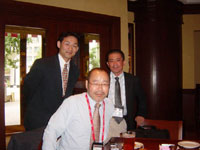 |
Drs Masutani and
Yoshimachi |
After finishing my role, I enjoyed to drink
several glasses of beer with Drs. Motomaru Masutani and
Fuminobu Yoshimachi. They are young but strong operators
through the radial approach and, of course, good friends
of mine. From 4:00 PM to 6:00 PM, I was one of the moderators
for the live transmissions from New York and Vancouver.
Dr. Takahiko Suzuki did a great job for a CTO case in the
right coronary artery from New York.
I met Dr. Hideaki Kaneda, who used to be the fellow in my
hospital and is now studying IVUS in Stanford University
in California. We went to one of the best Italian Restaurants
in Washington DC to have a dinner with Drs.
John Coppola and Tak W. Kwan from St. Vincent's Hospital,
New York. The day was just the 38th birthday of Dr.
Kaneda. We had a very pleasant dinner together. I promised
with John that we would have the 2nd TRI live demonstration
course in New York City just before ACC meeting next March
similar to this-year meeting.
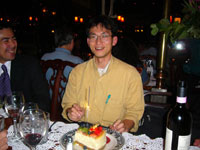 |
Dr. Kaneda |
|
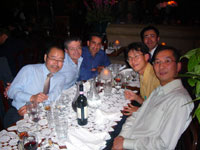 |
Dinner |
|
September 28Tuesday, 2004
I watched the live transmission from Clinique
Pasteur, Toulouse, France in the morning.
They were seriously discussing about the treatment strategy
for a 40-years old male diabetic patient with triple vessel
disease. Between 2 drug-eluting stents in the market, TAXUS
and Cypher, everybody felt that TAXUS would be better than
Cypher for the diabetic patients based on the scientific
results of TAXUS-III trial. However, the good data for diabetic
patients by the use of Cypher were shown during this TCT
meeting.
It is difficult how to train angioplasty skills for young
doctors. There was one interesting section, where 5 companies
were showing their computerized simulators for angioplasty
training.
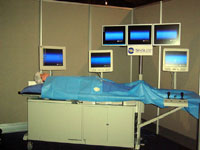 |
Simulator |
There simulators were surprisingly very
realistic as you could imagine from the photo.
I took a taxi at 10:00 AM from the hotel to the Airport
to the return flight to Japan (NH 001) departing at 12:20.
Again, this visit was very short but also very fruitful
for me.
米国訪問記II
湘南鎌倉総合病院
心臓センター循環器科 齋藤 滋
はじめに
9月から11月というのは我々にとって、いつも忙しい時では。世界中でPCI関係の重要な学会が開催されるからです。それらの中でも私にとってはTCT、CCTそしてキムニー・コースの3つがとても重要なものです。TCT
2004に出席するために全日空NH002便を使って成田空港から2004年9月26日日曜日に米国首都ワシントンのダレス国際空港に飛び立ちました。TCTいうのは"Transcatheter
Cardiovascular Therapeutics"のことであり、日本語では「カテーテルを用いた心血管治療学会」とでも呼べば良いかと思います。この学会はPCIの世界では最も大きくまた古くから存在するものの一つであり、Leon先生達によって運営されています。総参加人数という目で見ればEuroPCRの方が大きいかも知れません。しかし、規模という点で言えばTCTの方が明らかに大きいものです。私は1994年に"Initial
clinical experiences with rescue unipolar radiofrequency
thermal balloon angioplasty after abrupt or threatened vessel
closure complicating elective conventional balloon coronary
angioplasty"という論文を米国心臓病学会誌に出版しました(J Am Coll Cardiol
1994: 24; 1220-1228)。この論文を契機として、翌年のTCTで「高周波ホット・バルーンPTCAについて」の15分間の講演を主会場でするように、という招聘をLeon先生から受けました。当時日本からの招聘役員は延吉正清先生と私だけでした。その時からですのでもう10年間もTCTの招聘役員をしていることになります。
今年は米国内の12の病院、ヨーロッパの11の病院、カナダそしてアジア太平洋からそれぞれ1つずつの病院からライブデモンストレーション中継が行われました。アジアの病院は韓国ソウルのソウル中央病院でした。1999年9月24日金曜日に私はこのTCTに対して湘南鎌倉総合病院よりライブデモンストレーションを飛ばしました。日本と東海岸の間には13時間の時差がありますので、私は夜9時か10時まで(これは東海岸で朝8時から9時)、そして夜11時から真夜中12時まで(同朝10時か11時)の合計2時間に渡って私自身で合計7例のTRIによるPCIを行いました。この時のことは今でも鮮明に覚えています。とても大変でしたが同時にとても興奮する出来事でした。
ダレス国際空港に飛行機が着いたのは同日の朝10:30ぐらいでした。入国審査はそれほど大変ではありませんでした。ホテルにチェック・インするには早すぎる時刻でしたので、今回症例報告を行う私の部下の堂前君と共にタクシーで30分かけてホテルの近くの中華料理屋に直接行き昼ごはんをとることにしました。その後、会場近くのルネッサンス・ホテルにチェック・インしてから部屋で3時間ぐらい睡眠をとりました。
夕食はDuke臨床研究センターのKrucoff先生と共にアメリカ食の夕食をとりました。私はシャトー・ブリアン・ステーキをたのみました。味はとてもおいしいのですが、何しろ量が多いのでした。夕食をとりながら私たちは日本において良い臨床研究を推進していくためには我々自身が何をできるかについて議論しました。この議論はとても有意義でした。
2004年9月27日月曜日
 |
Old Convention
center |
朝食をすませてからワシントン学会場に歩きました。首都ワシントン市は古い学会場を持っていました。しかし、その建物は古くまた大きな学会を行うには手狭となりましたので新しい学会場を市街地再生プランの一環として建築することが決まりました。
 |
New Convention
center |
|
 |
Main Arena |
|
新しい学会場は昔の学会場と1ブロックしか離れていません。新しい学会場はとても巨大な建物です。
私は役員室に入り、そこで参加証、経費清算書その他の書類を受け取りました。それから主会場に向かいました。ドイツのSieberg心臓病センターとニューヨークのコロンビア大学Presbyterian病院からのライブデモンストレーション中継を行っていました。Grube先生は新しい自己拡張型の薬剤溶出性分岐部ステントの症例を行い、ニューヨークからは新しい型のカッティング・バルーンの症例を行っていました。これらのライブデモンストレーションは予定よりも30分余計にかかってしまったため、Serruys教授による「薬剤溶出性ステントはPCIをどのように変革したか」という基調講演は10:30
AMから始まりました。彼はこの中で薬剤溶出性ステント開発の歴史について語りました。ついで、Stone先生による「米国における薬剤溶出性ステント中毒」という講演が行われました。彼は、薬剤溶出性ステントの時代には如何にEBM(Evidence-Based
Medicine = 科学的証拠に基づいた医学)が重要であるか、ということを講演しました。
 |
Professor Patrick
Serruys |
毎年TCTの会期中に多くの重要な臨床研究の最新の結果が開示されます。私が最も興奮したのはARTS-II試験の結果でした。この成績は試験責任者であるSerruys教授によって示されました。ARTSというのは"Arterial
Revascularization Therapies Study"であり、日本語では「動脈血行再建治療に関する研究」でしょうか。何れにしても多枝患者さんに対してステントを用いたPCIと冠動脈バイパス手術(CABG)のどちらが良いかを調べようという研究です。Bare-metalステントの時代に行われたARTS-I試験ではBare-metalステントを用いたPCIと、冠動脈バイパス手術の成績が比較されました。ARTS-II試験では、Cypherステントを用いた607人の患者さんに対するPCIの結果がARTS-Iの冠動脈バイパス手術群と比較されました。示された結果はとてもエキサイティングでしたが、外科医にとっては最悪かも知れません。治療後30日後の成績で見れば、MACCE(主要脳心臓事故)発生率はARTS-I
PCI群、ARTS-I CABG群そしてARTS-II群でそれぞれ9.2%、6.3%、2.8% (p<0.005)でありました。また180日後のMACCEにならない率はそれぞれ80.0%、91.0%、93.6%でした。これらの結果から、薬剤溶出性ステントを用いたPCIは多枝病変症例に対して少なくとも冠動脈バイパス手術と同等の成績をもたらすことが明らかです。心臓外科医は冠動脈バイパス手術だけやっていたならば、これからは生きていけない時代です。
0:15 PMから1:45 PMの間は慢性完全閉塞病変のセクションでの症例呈示演者でした。座長はArizonaのHeuser先生でした。私は大変難しい症例を呈示しました。引き続いて光藤先生が2例呈示しました。
 |
Drs Masutani and
Yoshimachi |
私はこの仕事を終えてから舛谷先生と吉町先生と楽しくビールを飲みました。彼らは若いですがとても強力なTRI信奉者ですし、もちろん私の良き友です。
4:00 PMから6:00 PMまでの間、私はNew YorkとVancouverからのライブデモンストレーション中継のモデレーターとなりました。鈴木孝彦先生はNew
Yorkで右冠動脈の慢性完全閉塞病変に対してとても良い仕事をしました。
金田先生は以前、私の部下であり現在はStanford大学で冠動脈内超音波検査(IVUS)の研究中です。この日はNew
YorkのSt. Vincent病院のCoppola先生、Kwan先生と夕食をとるためにワシントンで一番良いイタリア料理のレストランにタクシーで向かいました。その日は丁度、金田先生の38回目の誕生日でした。私たちはとても楽しい夕食を摂りました。Coppola先生と来年3月のACCの前にNew
Yorkで2回目のTRIライブを行うことを誓い合いました。
 |
Dr. Kaneda |
|
 |
Dinner |
|
2004年9月28日火曜日
朝はフランス・ツールースにあるパスツール病院からのライブ中継を見ました。40歳の糖尿病がある3枝病変の男性患者さんの治療戦略について真剣な討議がなされていました。
現在市場に出回っている薬剤溶出性ステントにはTAXUSとCypherの2種類がありますが、TAXUS-III試験の科学的データに基づいて糖尿病患者さんに対してはCypherよりもTAXUSが良いと皆が思ってきました。しかし、このTCTではCypherを糖尿病患者さんに用いても同様に良好な結果が得られることが示されました。
 |
Simulator |
若い医師に経皮的冠動脈インターベンションのテクニックをどのように訓練するか、というのは難しい問題です。興味深い一区画がありました。そこでは5つの会社が経皮的冠動脈インターベンション訓練用コンピューター・シミュレーターを展示していました。これらのシミュレーターは写真をご覧になればお分かりの如く、とてもリアルで驚きます。
12:20発の日本に帰る便(NH001)に乗るために10:00 AMにはホテルからタクシーを拾い空港に向かいました。今回もとても短い滞在でしたが、それでも私にとってはとっても有意義な旅でした。
|